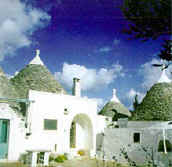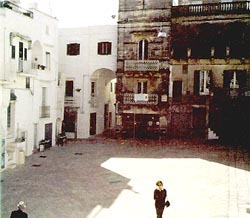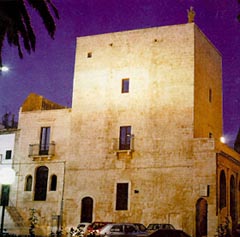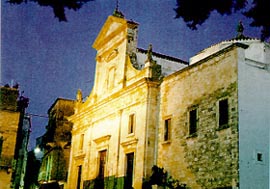|
|
history
Laughing
and lindo country to collinare (394 m. above sea level), arrogant
pointed out to South-West on the splendid one they of tempestata Itria
of trulli Goes. The territory of the Common one of Cisternino was
inhabited, since the medium Paleolitico - advanced, from coming from
human nuclei from the north of the peninsula or the area
sicilian-African and that they left, on hills where they fixed their
encampments age them, numerous traces of their life, given over to the
hunting and the collection of spontaneous and tuberi fruits. Still
today, in zone Specchia the mount, on the necks of They remain and on
the uncultivated cliffs of Bitter Greenhouse, preistorici tools of
every kind are recovered: tips of zagaglie, blades, scrapings and
burins in order to record bones. These human communities went more and
more infittendo, until catching up a considerable number of takeovers
in the Age of the Bronze; tens of stations of this Age have been
recently localized in several zones of the territory and those of
Maselli, small Ibernia, Carperi, mount of Alessio, mount the Fergole
and Figazzano, have a not indifferent importance for the understanding
of the preistoria brindisina.

|
I trulli photo M. Zizzi
|
The
contribution of civilization overseas and the discovery of the metals,
carried to the exhaustion of the function of these capannicoli villages
that rose, nearly all, along paleoalvei of rivers hour passings or near
extended doline, and carried to the edificazione of first agglomerate
to you city in the zones of Calabrian, Monsignor, Saint Salvatore and
Gianecchia, where they have been recovered, in the agricultural,
necropoli and ruderi course of the job of rooms. The legend wants that
Cisternino draws its denomination from the mythical founder eponimo
called Sturnoi, companion of Diomede. Sturnoi, after to have
participated to the messapica alloy against Taranto, divenne Roman
center and called Sturninum and probably it was destroyed in the 216 to
C., during the raids of Hannibal in Puglia, because of the barbaric
invasions. The monaci basiliani, come from the East in the eighth
century, they noticed in these contrade the ruins of the ancient center
and to they they referred when, wanting to just localize the abbey of
Greek ritual from they built up where today the church rises matrix,
they indicated it like “Saint Nicolò cis-Sturninum”. Around the Greek
abbey the first houses of agriculturists rose, of shepherds and of
craftsmen and the country house of Cisturninum, name for before the
time in a bubble of the 1180 that Pope Alexander III° sended to
Stefano, bishop of Monopolies was formed therefore, confirming the
belongings “ecclesiam Knows Nicolai to you de Cisternino cum Country
houses its, ecclesiam S.Maria de Berni cum country houses its”, to the
Episcopal Catering Monopolitana.

|
|
Madonna of the Cardellino |
Never
he has not known himself like Cisternino is last to the bishops of
Monopolies, but it was sure consequence of the secular fight between
the church of Greek ritual and that Latin. Around to the 1330
Cisternino Brig to Princivalle di Santacroce was sold simoniacamente
from the Paschal bishop, monopolitano nobleman. For a Cisternino
century it had civil barons and in the first half of the 1400 we find
its baron the monopolitano Nicholas Indelli; in this period the citizen
was encircled of walls, inframezzate from cylindrical and square
towers. In 1463, when Ferdinand I° of Aragon came in Puglia in order to
suffocate the rebellion of Giovanni Antonio Orsini, Prince of Taranto,
the bishop of Monopolies, Manfredi, caught up it near Ruvo and
churches, between the other that Cisternino returned to belong to the
Episcopal Catering. Ferdinand, having in that moment need of allies,
granted to Manfredi bishop the barony to you of the country house. In
1495, Cisternino was conquered the Most serene Republic of Venice, than
it held it, until 1528, when it was acquired from the Spanish.

|
|
Public square of the clock
photo M. Zizzi
|
In
that time we find the nobleman of Spain, Galeotto Fonseca, baron of
Cisternino. Malgoverno the part, the fiscal oppression of the bishop
from the other, made to pass years of torments and misery to the
population that learned to appreciate the freedom. It was for that
every antifeudale motion found the citizens of Cisternino in before
row. In 1647, following the example of Masaniello to Naples, they
rebelled against the bishop-baron and they burnt its residence. In 1799
it was citadel democratic and it received the relatives of writer
Ignazio Ciaia, president of the Partenopea Republic. An other son of
Cisternino, Nicholas Semeraro, head of the republican nucleus of
Francavilla Fontana, was slaughtered in that city from the realists. In
the 1820 active it was the Sale Carbonara di Cisternino that numbered
one ottantina of supporters between religious, professionals and
craftsmen. She was Giuseppe Capece di Cisternino to raise on the fort
of Drinks a toast the tricolour flag, after to have torn the vessillo
borbonico. Subsequently a mazziniano, adherent nucleus was created to
the “Young Italy”. In 1848, when the borbonico government, ligio to
Austria, was gotten ready to to call to the crews the population,
Cisternino rebelled and prevented that it was proceeded to the lever
operations. The population puts into effect counts them 12,204
inhabitants.
cultura&tradizioni
festival and cultural initiatives
AlterFesta |
Pietre che cantano| Festival
delle Bande “Valle d'Itria”
the folkloristiche manifestations and the festivals
The Monday of Passover
“To Pasquarèdde” for ancient tradition, us os to the Sanctuary of the
Madonna d' Ibernia (Madonna de Bernis) to 3 km from the inhabited
center, with a cake to shape of purse with two hard eggs for the
maschietti and to shape of doll with a hard egg in the grembo for the
femminucce. This characteristic cake “u chrruchl” has fecundity
meaning. The Vergine d' Ibernia is the Madonna of the abundance, the
life and the happiness.
fairs and markets
the festivals
- Festival of the orecchiette, August Caranna fraction.
- Popular festival of the rabbit, August in the fraction of Marinelli.
- Festival of the grape, September: fraction of Casalini.
the religious rituali
- S. Antonio from Padova, 13 June.
- Madonna D' Ibernia, monday of Passover.
SS,. Medici C.da Marinelli, July. Madonna di Fatima to the C.da Sisto, July. Saint Immaculate Maria C.da Casalini, August. Given pain Maria C.da Caranna, August. SS. Protecting Quirico and Giulitta, August patronale Festivity of the country, with shows, luminarie, extensions of handicraft.
situated the archaeological ones
Sanctuary of the Madonna d' Ibernia
In the vicinities of the Sanctuary, the surrounding land is cosparso of
reperti ceramic of roman age and medioevale, the recovery of tombe and
a capitello bizantino, leaves to suppose that the sanctuary rises on
the ruins of an inhabited center, that it had between the city
structures, one paleocristiana church.
the architectonic assets
- Historical center; characterized from spontaneous architecture: alleys, arch contrafforti, ladders, balconies remained intact in the time;
- The Cimetero di Sant' Anna Outside Mura
- Bridge of the Madonna; on which it dominates the palace Loved

|
Torre Normanno-Svveva photo M. Zizzi
|
- Torre Normanno-Sveva or of Large Door;
it was the main income to the country. High approximately 17 meters, on
its top small statue of S.Nicola is placed one and incorporates in the
covering the ancient tower. All the last one of which in 1995 has been
object of repairs.
- Episcopal or Baronial palace;
constructed in 1560. On the rests of the external facade, in via
Castle, two can be noticed stone to death with the coats of arms of the
bishop and baron, prodromi of the communal coat of arms.
- Palazzo Capece with annexed Tower of the Wind
- Palace of the Governor
- Palozzotto Signorile C.da Monreale; situated in the omonima contrada, currently center of one agricultural company;
- Salesiano institute “Sacred Heart”
- Convent of the Monaci Cappuccini with Church of S. Antonio; currently center of the hospital
-
Sanctuary of the Madonna d' Ibernia (Madonna de Bernis);
situated to 3 km from the inhabited center. The first one I point out
on the sanctuary we find in one bubble to it sended from Pope Alexander
III in 1180 to Stefano Vescovo of Monopolies, for confermargli the
ecclesiastical jurisdiction on it. According to the tradition, the
Vergine Maria with an apparition indicated same she, leaving a track of
the foot on the cliff, the precise point where it wanted that the
sanctuary rose. The surrounding land cosparso of reperti ceramic of
roman and medioevale age, the recovery of tombe and a capitello
bizantino, leaves to suppose that the sanctuary rises on the ruins of
an inhabited center, that it had between the city structures, one
paleocristiana church. The Vergine d' Ibernia is the Madonna of the
abundance, the life and the happiness. The monday “to Pasquarèdde” and
ferragosto, for ancient tradition, the faithfuls, os in pilgrimage to
the Sanctuary. -
Church of S. Cataldo -
Church of S. Quirico;
on the place where the Saint appeared, freeing therefore the community
from the flagellum of the plague, it was erected in the second half of
the 1600 church who in succesivi times accommodated “the wheel”, used
for the not intentional, exposed sons and visible to east in the small
space-window that lead to the house of the caretaker.

|
Church Matrix photo M. Zizzi
|
- New church or of the Sacramento
- Church of S. Cataldo; of Century XVIII
- Church Matrix;
of century XIV, dedicated to the cult of S.Nicola di Patara and
constructed on one ancient church of monaci the Basiliani. In it two
alive works in stone are present signed from the Magnificent scultore
“Stephanus Apulie Poteniani: S.Maria di Costantinopoli, known in the
history of the art like the Madonna of the Cardellino situated in
navata to right between the two Cappelloni of S. Rosary and the SS.
Smaller Sacramento and tabernacolo with putti and Ecce Homo, Paul Longo
to the cited Stefano from Putignano commissions you around to the 1517
from the Archpriest don.
illustrious personages
- Pasquale Lagravinese - Lawyer, writer, poet.
- Nicola Lagravinese - Doctor, writer, investigator.
- Quirico Punzi - Clergyman, university professor, benefactor, man of culture, founder of the Skillful school “Giannettino”.
- Vicenzino Punzi - dialectal Poet.
- Francesco Convertini - Missionary.
- Martino Carrieri - Insigne lawyer.
- Francesco Clarizia - Lawyer, politician.
personages of the country
- “zip-zip” - living monument of the festivities, madonnaro naif, jubox wandering, door santini.
- and many others ..........
atmosphere and parks
-
The forest Communal Mounts;
in the communal territory there are approximately 400 hectares of
forest of which it has 244.18.33 of communal property, places from 250
to 350 m s.l.m. The communal forests are the formation vegetable more
consisting of the province. Currently they are in course you work of
improvement with substitution of the pine of aleppo and the cypress,
with native latifoglie (fragno, rovella, leccio etc) that they are
harmonized better with the present essences, which carob tree, nettle
tree, carpinella, orniello, rustic maple tree, etc. The reforested
communal territories are approximately 42 hectares. -
Pineta and the Communal villa;
wonderful balcony on the splendid one Goes them of Itria, from which
the look reaches without obstacles until to Martina and Locorotondo.
The pineta in particular it is meeting for the local youth and hosts,
above all in the summery evenings.
routes
- Ecological routes;
in the zone of communal mounts during the jobs of thinning and
reforestation, they have been created new paths and they have been
restores those old existing ones to you, for trakking and walks.
- Walk for Goes it them of Itria; in order to admire the splendid ones trulli, the masserie and the walls to dry.
- Route with the Trenino Verde of the Railroads of South-East.
where to lodge: it reserves your vacation for information >>>
where to eat
- Taverna
della Torre traditional kitchen and international
Porta Grande www The enoteca|cantineria Cucco C.so Umberto I, 137 Tel. 080 4449064 www Trattoria Bella
Italia typical and atypical kitchen Via Duca
D'Aosta, 29 (historical center) Sant'Anna tavern restaurant Via Martina Franca (in
Valle d'itria)
From Tonia pizzeria restaurant typical kitchen Via Locorotondo, 52
Il Rugantino pizzeria restaurant Contrada Lamacesare
Il Capriccio pizzeria restaurant Caranna Locality
Il Quadrifoglio
pizzeria restaurant Casalini Locality
Cantone tavern restaurant (in
Valle d'itria) www
Il Vicoletto Rosticceria Via Santa Lucia (c.s.)
Zio Pietro Rosticceria Via Duca
D'Aosta (c.s.)
Al
Vecchio fornello Rosticceria Via Basiliani (c.s.)
Piazza Nuova Rosticceria P.zza Red P. (c.s.)
Doppio Zero pizzeria P.zza
P. Rossi (c.s.)
TRATTORIA
La BOTTE, Via Saint Lucia (c.s.)
TRATTORIA OF the HISTORICAL CENTER, Via Regina Elena (c.s.)
BIBLIOGRAPHY Communal offices of Cisternino. Documentation.
Antore. The Bishops of Monopolies.
G. Rabbit. Visitors of the Viceregno of Naples. Printing office of the South Bariums.
Fat G. Historical news of Cisternino.
To. De Vitofranceschi. Historical signal of Cisternino and bibliography of the SS Quirico and Giulitta. Of the Old C#lecce, 1876.
L. Pepper. History of the city of Ostuni from 1463 to 1639. Frogs, 1894.
To. Caggiano, S. Ostuni, R. Semeraro, M.L. Hermann. The Notebooks of the For-Native place, Relations. Grafischena, Fasano, 1980.
Region Puglia C.R.S.E.C. Ostuni. The Historical-documentary archives. |